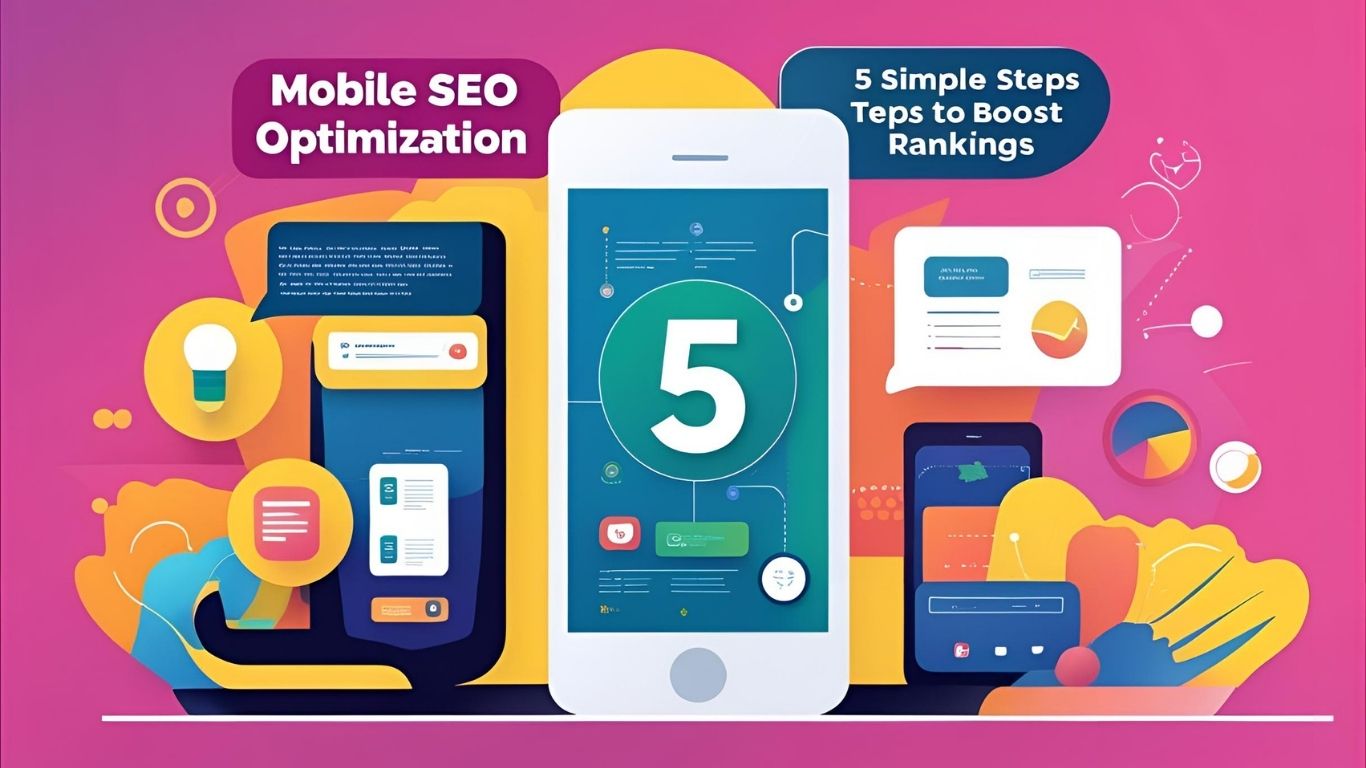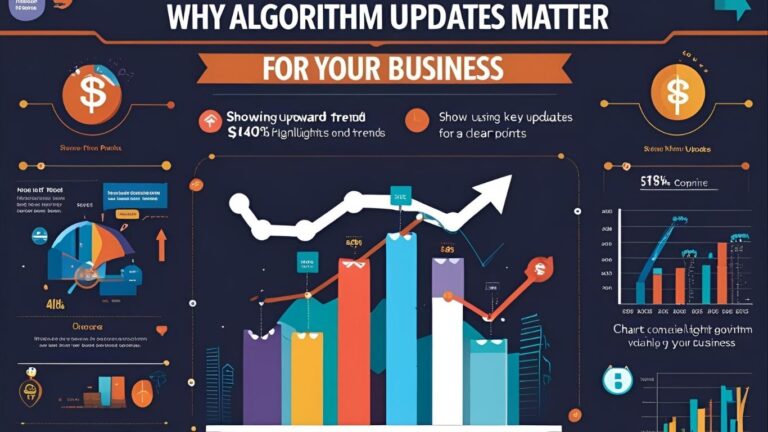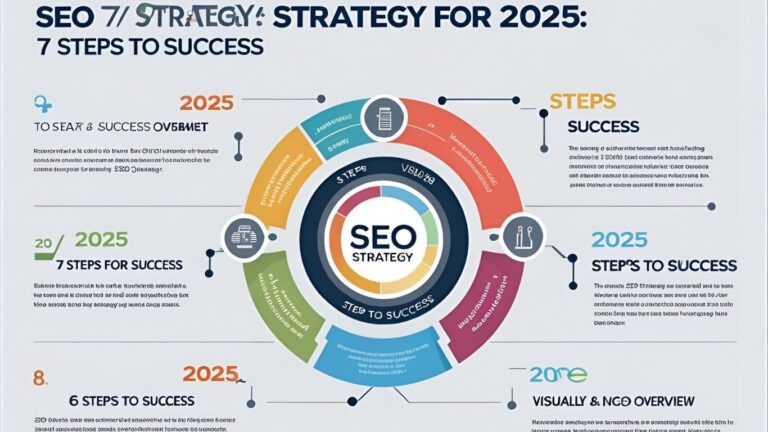Master Mobile SEO: 5 Key Steps to Optimize and Rank Higher #SEO
Mobile SEO Optimization Guide: 5 Simple Steps to Boost Rankings
In today’s digital age, where over half of all internet traffic comes from mobile devices, ensuring your website is optimized for mobile is no longer just a recommendation—it’s a necessity. As businesses strive to stay ahead in an increasingly competitive online world, mobile SEO optimization stands out as a critical factor that can determine your website’s success. If your website isn’t mobile-friendly, you might be losing out on a significant chunk of traffic. But fret not—this Mobile SEO Optimization Guide will show you how to optimize for mobile, increase your rankings, and improve user experience with just five simple steps.
We live in a time when mobile search has surpassed desktop search. In fact, more people are reaching for their smartphones than ever before to search for businesses, products, and services. With Google’s shift to mobile-first indexing, it’s not just a trend anymore—it’s the new reality. Think about it like this: Imagine you’re a shopkeeper. If your store is messy and hard to navigate, customers will leave before buying anything. A website that isn’t optimized for mobile is exactly like that messy shop—it turns people away. But with these five steps, we’ll turn your site into a well-organized, attractive, and mobile-friendly storefront, helping you build a stronger, more engaged audience.
Step 1: Implement Responsive Design for Better User Experience
The foundation of a mobile-friendly website starts with responsive design. This ensures that your website’s layout adapts to any screen size, providing a seamless experience across smartphones, tablets, and desktops. Without responsive design, your visitors may have to zoom in or scroll horizontally—both of which can frustrate users and cause them to leave your site quickly. In a world where attention spans are shorter than ever, the Mobile SEO Optimization Guide stresses that your site’s design is the first impression that can make or break your rankings.
What is Responsive Design?
Responsive design is like a shapeshifter for your website. It’s the ability to adjust the content and layout of your site based on the device your visitor is using. Whether they’re on a tablet, phone, or desktop, responsive design ensures that your website is easily navigable without any awkward zooming or scrolling. For example, think of it like the weather: a well-fitting jacket can protect you from both rain and cold. Similarly, a responsive website adapts to all the varied “conditions” of the devices it’s viewed on, ensuring that your visitors always have a smooth experience.
Benefits of Responsive Design
Responsive design not only benefits users but also Google’s ranking algorithm. Websites with mobile-friendly designs rank higher than those that aren’t optimized for mobile. Google, in its bid to improve user experience, prefers sites that cater to mobile-first indexing. By ensuring that your website automatically adjusts to any device, you increase your chances of appearing in higher positions on the search engine results pages (SERPs).
Here’s a simple list of the benefits of responsive design:
Improved User Experience: Visitors can easily navigate your site on any device.
Faster Loading Times: Mobile-optimized sites tend to load faster, which reduces bounce rates.
Higher Search Rankings: Google ranks mobile-friendly websites higher, improving visibility.
Step 2: Improve Page Speed for Faster Loading
If there’s one thing that mobile users can’t stand, it’s slow-loading websites. The minute they feel frustrated waiting for a page to load, they’ll leave and find a competitor who offers a quicker, smoother experience. Mobile SEO Optimization Guide emphasizes the importance of page speed in improving mobile SEO performance.
Why Speed is Key for Mobile SEO
Imagine you’re racing in a car. If you’re stuck in traffic, you’re not going anywhere fast. The same goes for websites: slow page speed leads to poor user experience, higher bounce rates, and lower conversions. In fact, Google’s Core Web Vitals now include page load speed as a ranking factor. Slow websites not only lose potential customers but also lose ranking positions.
Tools to Measure Your Page Speed
There are several free tools available to measure and optimize your site’s page speed:
Google PageSpeed Insights: This tool provides valuable insights into how fast your website loads and suggestions for improving speed.
GTmetrix: GTmetrix analyzes your page speed and gives you a breakdown of what needs to be fixed.
Pingdom: Another excellent tool that measures website load time and provides actionable insights.
Pro Tip:
To make your mobile site faster, always use compressed images and minimize the use of heavy media. You want your site to load in under 3 seconds—anything longer than that could cause potential customers to bounce.
Here’s how to improve your page speed:
Optimize Images: Use compressed formats like JPEG or WebP.
Minimize JavaScript and CSS: Reduce unused code to make your pages load faster.
Leverage Browser Caching: This allows frequently used resources to be stored, so visitors don’t have to re-download them every time they visit your site.
Step 3: Create Mobile-Friendly Content
Creating content that’s optimized for mobile isn’t just about fitting it into a small screen. It’s about presenting your information in a way that’s easy to consume, even on a small device. Mobile users often skim and scroll, so your content needs to grab attention quickly. The Mobile SEO Optimization Guide advocates for a careful balance of short, engaging content and user-friendly design.
Crafting Content for Smaller Screens
When writing for mobile users, always think about readability. Small fonts, long paragraphs, and clunky design make it hard for users to engage with your content. Mobile users are more likely to read shorter, punchier content. So, keep your paragraphs brief, use larger fonts, and make your content scannable by breaking it into easily digestible chunks.
Optimizing Text and Images
Along with text, your images need to be optimized for mobile. Mobile users expect your site to load quickly, which means heavy image files can seriously hinder the user experience. It’s crucial to use optimized images and avoid large, uncompressed files.
Here are a few tips for creating mobile-friendly content:
Use Short Paragraphs: Each paragraph should contain fewer than 150 words.
Optimize Font Sizes: Ensure your text is readable on smaller screens.
Break Up Text: Use headings, subheadings, and bullet points for easy scanning.
Compress Images: Tools like TinyPNG can help reduce image size without compromising quality.
Step 4: Focus on Local SEO for Mobile Devices
A significant portion of mobile searches is driven by location. Users are often searching for businesses or services near them, such as “restaurants near me” or “plumbers in [city name].” Local SEO is essential in helping your business show up when people are searching for products and services nearby. The Mobile SEO Optimization Guide highlights how crucial local SEO is in today’s mobile-driven world.
Importance of Local SEO on Mobile
Did you know that mobile users are more likely to make purchasing decisions on the go? In fact, studies show that 76% of people who search for something nearby visit a business within a day. This means that your website needs to be optimized not just for mobile but for local searches as well.
How to Optimize for Local Search
Claim Your Google My Business Listing: This is the first step to ranking in local search results. Make sure your business name, address, and phone number (NAP) are consistent across all platforms.
Add Local Keywords: Incorporate location-based keywords in your content, such as your city, neighborhood, or region.
Encourage Reviews: Positive reviews on platforms like Google and Yelp can boost your credibility and help with rankings.
Local SEO is like putting a neon sign outside your brick-and-mortar shop. When someone nearby searches for your product or service, your website should be the first thing they see.
Step 5: Optimize Mobile-Friendly Backlinks
Backlinks are like recommendations in the online world. The more high-quality backlinks you have, the more authoritative and trustworthy your website appears in the eyes of search engines. But here’s the catch—mobile-friendly backlinks matter too. The Mobile SEO Optimization Guide suggests you focus on building backlinks that come from mobile-optimized sites to enhance your site’s ranking.
The Importance of Quality Backlinks
Backlinks from credible, mobile-friendly websites are more powerful than traditional backlinks. Google evaluates these backlinks not just based on their authority but also on how well the linking website is optimized for mobile. Therefore, it’s essential to focus on obtaining links from high-quality mobile-responsive websites.
How to Build Mobile-Specific Links
Guest Blogging: Write guest posts for mobile-optimized blogs in your niche. This not only helps build backlinks but also gets you in front of a mobile audience.
Social Media: Links from social media platforms like Facebook and Instagram can also improve your mobile rankings.
Directories: Submit your website to reputable, mobile-friendly business directories in your industry.
Conclusion: Bringing It All Together for Effective Mobile SEO
Mobile SEO is a powerful tool in today’s online landscape, and optimizing your website for mobile can significantly improve your search rankings, traffic, and user experience. By implementing responsive design, improving page speed, creating mobile-friendly content, focusing on local SEO, and optimizing backlinks, you’ll be well on your way to mastering mobile SEO and increasing your website’s visibility.
Now that you’ve explored the Mobile SEO Optimization Guide, it’s time to start implementing these strategies. Don’t wait for mobile-first indexing to catch up with you—take action now and see the results unfold!
Bullet-Point Summary:
- Mobile SEO Optimization is crucial for boosting rankings and improving user experience.
- A responsive design ensures a seamless experience across all devices, increasing rankings and reducing bounce rates.
- Page speed plays a critical role in mobile SEO. Faster websites rank higher and retain users.
- Mobile-friendly content is key. Short, engaging text and optimized images keep mobile users engaged.
- Local SEO is vital, with mobile searches often focused on finding nearby businesses and services.
- Optimizing backlinks from mobile-friendly sites boosts your site’s credibility and search engine performance.
- Google’s mobile-first indexing means that mobile-friendly websites are prioritized in rankings.
- Responsive design adjusts website content for optimal viewing on various screen sizes, making it a core element of mobile optimization.
- AMP (Accelerated Mobile Pages) can help improve load times for faster mobile experiences.
- Mobile-first indexing highlights the importance of having a mobile-optimized site for better visibility.
- Google My Business and location-specific keywords are vital for local mobile search optimization.
- Optimizing for local search helps increase visibility in mobile searches for location-based queries.
- Mobile optimization tools, such as Google PageSpeed Insights and GTmetrix, provide insights for improving mobile website performance.
- Backlinking from mobile-friendly websites enhances SEO by signaling to Google that your site is trusted and valuable.
- Focus on user experience—a mobile-friendly website with quick loading times increases both engagement and conversions.
Unique FAQs with Answers
What is mobile SEO?Mobile SEO refers to optimizing your website for mobile devices, ensuring it loads quickly, provides a smooth user experience, and ranks well in search engine results. It includes practices like responsive design, fast loading speeds, and local SEO optimization.
Why is responsive design important for mobile SEO?
Responsive design ensures that your website adapts to various screen sizes and devices. Google prioritizes responsive sites, making them more likely to rank higher in search results. It’s crucial for providing a seamless experience for users on any device.
How does page speed affect mobile SEO?
Page speed is essential for mobile SEO because slow-loading pages can lead to higher bounce rates, lower engagement, and poor rankings. Faster websites tend to perform better in search engines and provide better user experiences.
What are Accelerated Mobile Pages (AMP)?
AMP is an open-source framework that helps create lightweight, fast-loading pages for mobile devices. Implementing AMP can improve your website’s mobile speed, enhancing rankings and user experience.
How can local SEO help with mobile SEO?
Mobile users often search for local businesses on the go. By optimizing your site for local search (e.g., using location-based keywords and setting up a Google My Business profile), you increase your chances of being discovered by nearby customers.
What is mobile-first indexing?
Mobile-first indexing means that Google primarily uses the mobile version of a website to determine its ranking, rather than the desktop version. Optimizing your site for mobile is now more important than ever to ensure visibility.
How do I improve my mobile website’s load time?
To improve mobile load times, compress images, minify CSS and JavaScript files, and leverage browser caching. Use tools like Google PageSpeed Insights to identify and fix performance issues.
Is it necessary to optimize content for mobile?
Yes! Mobile users tend to skim content. To keep them engaged, make sure your text is concise, easy to read, and formatted for small screens. Short paragraphs, bullet points, and clear headings are essential.
What are the key elements of mobile-friendly content?
Mobile-friendly content should be easily scannable, with short paragraphs, large fonts, and responsive images. It should also load quickly and be relevant to the user’s needs on mobile devices.
How do backlinks impact mobile SEO?
Backlinks from high-authority and mobile-friendly websites are crucial for improving your rankings. These backlinks tell search engines that your site is trustworthy and valuable, enhancing your mobile SEO efforts.
How can I track mobile SEO performance?
Use tools like Google Analytics and Google Search Console to track mobile-specific performance metrics, such as mobile traffic, bounce rates, and conversions. These insights help refine your strategy.
Does mobile SEO affect desktop SEO?
While mobile SEO primarily affects mobile search results, mobile optimization can also improve desktop rankings. Since Google now uses mobile-first indexing, improving your mobile site can positively impact your desktop performance as well.
How do I ensure my mobile site is user-friendly?
A user-friendly mobile site is fast, easy to navigate, and visually appealing. Focus on responsive design, optimize images, ensure clear call-to-action buttons, and provide relevant content tailored to mobile users.
What is the importance of Google My Business for mobile SEO?
Google My Business helps your local business appear in local search results and Google Maps, making it essential for mobile searches. Ensure your business information is accurate and up to date.
What are the most common mobile SEO mistakes?
Some common mistakes include not having a mobile-friendly design, slow load times, unoptimized images, and ignoring local SEO. These issues can negatively affect rankings and user experience.
Informative Links for Enhanced Understanding
Google Webmasters Blog – Stay updated with Google’s latest SEO news and best practices.
Moz Beginner’s Guide to SEO – A comprehensive guide to understanding the basics of SEO.
Search Engine Journal – A hub for the latest SEO news, strategies, and expert advice.
Explore These Valuable Resources
Google’s Mobile-Friendly Test Tool – Test if your website is mobile-friendly and see how you can improve.
GTmetrix – Analyze and improve your website’s load time and performance.
Google PageSpeed Insights – A powerful tool for measuring and enhancing your website’s page speed.
Recommended Reading for In-Depth Knowledge
Mobile First Indexing: What It Means for You – Deep dive into Google’s mobile-first indexing and its importance for SEO.
The Importance of Mobile SEO – Why mobile optimization is critical in today’s digital world.
External Links to Expand Your Understanding
Google’s Search Engine Optimization (SEO) Starter Guide – Official guide from Google on how to optimize your site for search engines.
Ahrefs Blog – Learn from SEO experts on advanced strategies, content marketing, and backlinking.
Unlock More Knowledge with These Links
HubSpot’s SEO Resources – Extensive resources and tools for improving SEO strategies.
Backlinko SEO Techniques – Detailed SEO techniques and strategies that help websites rank higher.
Enhance Your Learning with These Resources
Neil Patel’s SEO Guide – Learn SEO fundamentals from one of the industry’s leading experts.
Yoast SEO Blog – Tips and guides for mastering SEO and enhancing website visibility.
Dive Deeper with These Informative Links
Bing Webmaster Guidelines – Official guidelines for optimizing websites for Bing’s search engine.
Moz SEO Learning Center – A wide range of resources from Moz to help you master SEO at any level.
Expand Your Horizons with These Links
SEO PowerSuite Blog – Deep insights into SEO and digital marketing with expert opinions.
W3C Mobile Web Best Practices – Web standards and best practices for mobile websites.
Go Beyond with These Insightful Resources
Google Search Central – Explore Google’s official search tools and learn how to improve your website’s visibility.
SEMrush Blog – A go-to resource for SEO, PPC, and digital marketing strategies.
Discover More with These Expert Resources
Content Marketing Institute – Explore strategies for creating content that attracts and converts.
BrightEdge Blog – Learn from webinars and articles on advanced SEO strategies.
Learn from the Best with These References
Google Webmaster Guidelines – The official guide to what Google recommends for SEO practices.
SEO by the Sea – Learn from expert Bill Slawski’s analysis of search engine patents and algorithms.
Broaden Your Knowledge with These Sources
Google Analytics Academy – A free course offering insights into Google Analytics and its use in SEO.
Search Engine Watch – In-depth articles and industry analysis on SEO trends.
Access Premium Content Through These Links
SEO Tools by SEMrush – Explore SEMrush’s premium SEO tools for keyword research, site audits, and more.
Kissmetrics Blog – Learn advanced marketing and SEO strategies through this comprehensive blog.
Master the Topic with These Essential Resources
HubSpot Academy – SEO Training – Free course that covers SEO fundamentals and advanced strategies.
Ahrefs Academy – Free SEO courses to help you get better at SEO.
Stay Updated with These Authoritative Links
Search Engine Land – A reliable source for daily news and updates in the world of search engine optimization.
Moz Top 10 – A list of the most important SEO insights, articles, and resources.
Level Up Your Skills with These Guides
Google Search Console Help Center – Learn how to use Google Search Console to track your SEO performance.
Screaming Frog SEO Tools – A powerful tool for analyzing and auditing websites from an SEO perspective.
Find Expert Insights Through These Links
Content Strategy Resources by CopyBlogger – Expert tips on crafting compelling content strategies that enhance SEO.
BuzzSumo’s Content Research Tool – Discover high-performing content ideas to boost your SEO rankings.
By incorporating these resources into your research and strategy, you can improve your understanding of SEO, mobile optimization, and other essential digital marketing techniques
Blog Recommendation
If you’re looking for more insights on digital marketing, SEO, and web development, I highly recommend checking out this blog. It’s packed with valuable resources to help you stay ahead in the ever-changing world of SEO and online marketing.
Services
If you’re ready to take your website to the next level, explore our range of services at GetRizwan Services. From SEO and web design to e-commerce solutions, we’re here to help you succeed online.
Portfolio
Take a look at our past projects and see how we’ve helped businesses thrive online. Check out our portfolio at GetRizwan Portfolio to see the range of services and results we’ve delivered.
Shop
Ready to get started on your own project? Visit our e-commerce shop for high-quality tools and resources to help you optimize and build your website, enhance SEO, and improve overall performance.
LinkedIn
Connect with me on LinkedIn to stay updated on the latest trends, strategies, and insights in SEO, digital marketing, and web development. Let’s connect and collaborate!







